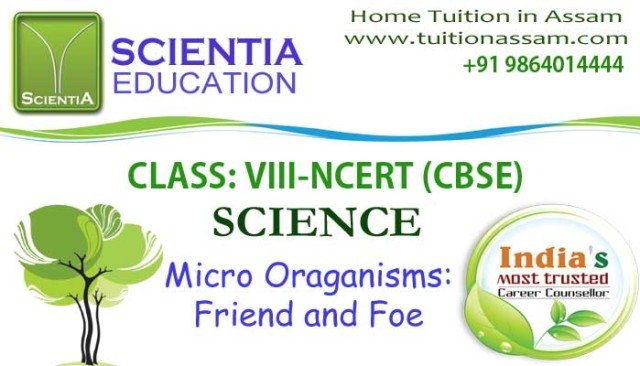
CLASS: VIII NCERT (CBSE)
Biology
Micro Oraganisms: Friend and Foe
SUMMARY
World of Micro Organisms
It’ll be exciting to learn about microbes because we humans have microbes in our bodies, too. Living organisms invisible to the naked eye are calledmicroorganisms. Some microbes can be seen on bread with the help of a magnifying glass, while others are visible only under a microscope. Microorganisms are everywhere, in the air, water and soil. Bread mouldbelongs to the fungi group. Microbes can be classified into four groups – bacteria, fungi, algae and protozoa
.Cold and influenza (flu) are caused by viruses. Serious diseases like polio and chicken-pox are also caused by viruses.Viruses need to be inside a living organism to reproduce. Hence, viruses form the boundary between the living and the non-living world. Anamoeba is a free living organism.
Microbes can survive under all types of environment, ranging from ice cold climate to hot springs and deserts to marshy lands.
Microorganisms made of single cells are called unicellular organisms. Most fungi and some algae are made up of many cells, and are called multicellularorganisms. Milk is turned into curd by the action ofLactobacillus. Microbes are used in the preparation ofcake and bread. Yeast reproduces rapidly in dough and produces carbon dioxide. This dough, when baked, yields porous and spongy cakes.
Microbes are also used to prepare pickles, cheese and alcohol. Bacteriaclean up organic waste and decompose them into usable substances. Louis Pasteur discovered the process of fermentation. The process of converting sugar into alcohol is called fermentation. Yeast convert the natural sugars present in grains into alcohol. Wineis produced by the process of fermentation.
Dealing with Harmful Micro Organisms
It is exciting to see Vex explaining about disease-causing microbes, which are called pathogens.Microbesspoil leather, clothing etc.Some more information was given on the transmission and spread of diseases.Female mosquitoes carry the pathogens for diseases like malaria and dengue, and spread infectionfrom one person to another.By using a handkerchiefwhile sneezing or coughing, we can prevent the spread of infection.Infections are transmitted from animals to humans by eating uncooked chicken.
Human diseaseslike cholera, common cold, chicken pox and tuberculosis spread from an infected person to a healthy person through air, water, food or physical contact.Microbial infection can be transmitted by direct contact with an infected person or animal, or by eating meat prepared from an infected animal.
To prevent microbial infection in animals, antibiotics are mixed with the feed of livestockand poultry.Many pathogens attack crop plants like sugarcane, wheat, rice, potato and orange, and reduce their yield.Antibiotics, insecticides and pesticides are sprayed in the field to control many plant diseases.Anthrax, caused by a bacterium, is a dangerous human and cattle disease.
The foot and mouth disease in cattle is caused by a virus.Antibiotics are used to cure a variety of diseases caused by fungi, bacteria and protozoa, but antibiotics are not effective against diseases caused by viruses.We should take antibiotics only on the advice of a qualified doctor.
Medicinal use of microbes- Bacteria or fungi produce a specific chemical that prevents the growth of or kills microbes that cause disease.Penicillin was discovered by Alexander Fleming in 1929.Inactivated orweakened microbes introduced into the body are called a vaccine.When disease-carrying microbes enter our body, it produces self-protecting proteins calledantibodies, to fight against the invader.Small pox has been completely eradicated from the world. Several diseases, including cholera, tuberculosis and hepatitis,can be prevented by vaccination.
Food Preservation
Food poisoning may cause infection.We need to store our food properly as food poisoning can cause serious illness and even death.Spoiled food emits a bad smell, has a bad taste and changes colour.Chemical methodsof preservation of jams and squashes use preservatives like sodium benzoate and sodium metabisulphite.Common salt absorbs moisture from food, making it dry and uninhabitable for microbes.
Sugarreduces moisture in food, which inhibits the growth of microbes that spoil food. Jams, jellies and squashesare preserved using sugar.Bacteria and fungi cannot live in an environment of oil and vinegar.Louis Pasteurdiscovered the process of pasteurisation.Duringpasteurisation, milk is first heated to about 70 degrees Celsius for 15 to 30 seconds and then suddenly chilled.Sudden chilling of milk is done during pasteurisation to prevent the growth of microbes.Boilingand freezing are the two other methods used to preserve food.
Nitrogen Fixation
The conversion of atmospheric nitrogen into nitrogenous compounds is nitrogen fixation.Rhizobium bacteria living in the root nodules of legume plants, fix nitrogen from the atmosphere.Microorganisms in the soil convert atmospheric nitrogen into ammonium compounds, thereby enabling the survival of plants and animals.Nitrogen is an essential constituent of proteins, nucleic acids, chlorophyll and vitamins.
Blue green algae are able to fix nitrogen from the atmosphere.Nitrogen from the atmosphere is fixed bybiological nitrogen fixers like blue green algae and some bacteria.Fungi are decomposers that degrade organic waste compounds into simple substances, ready for reuse by plants.The circulation of nitrogen between organisms and the atmosphere is called the nitrogen cycle.
Some microorganisms reside in the root nodules of leguminous plants and fix nitrogen from the air into the soil, and increase soil fertility.Nitrogen is also fixed by lightning to a small extent.Microorganisms in soil decompose harmful and smelly substances, leading to a cleaner environment.














